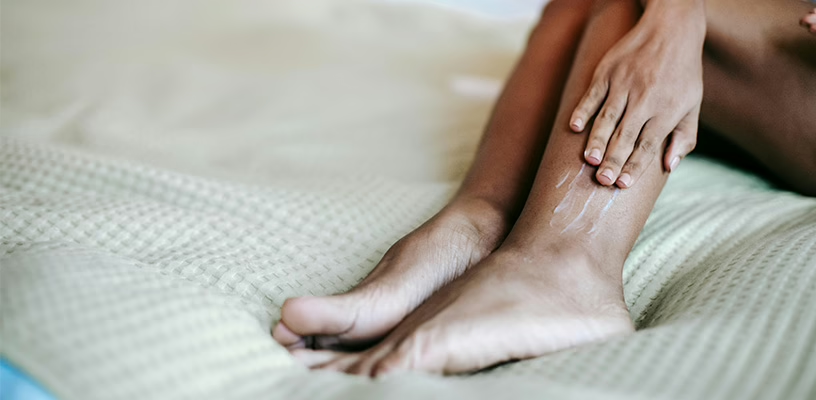Postpartum Swelling: What It Is and How to Manage It
After giving birth, you’re no doubt thrilled to be back home with your new bundle of joy. Although this is an exciting period, your body has been through a lot, and it may take a while for you to get back to your pre-pregnancy body.

One issue many new moms deal with after giving birth is postpartum swelling. This condition is exactly what it sounds like: swelling in your feet, legs, hands, and face. It can be unpleasant, but most cases clear up quickly, and yours will probably pass by the time your baby turns one week old.
However, a few (relatively rare) symptoms that sometimes accompany postpartum swelling can be a cause for concern. Read on to find out what postpartum swelling is, when you should see a doctor, and how to manage it.
What is postpartum swelling?
Postpartum swelling, also known as postpartum edema, happens when you get a buildup of excess fluid in your body after giving birth. 1
It can be concerning to see your body swell up so much, but swelling is a normal part of the recovery process. It means your body is working hard to eliminate the fluids you retained during your pregnancy and delivery.
What causes postpartum swelling?
When you’re pregnant, your surging hormones lead to increased fluid retention, and your blood volume expands by up to 50% to support your growing baby. 1
When you deliver your baby, these fluids don’t immediately disappear. They may travel to other parts of your body before you eliminate them. The “migration” of these fluids can be exacerbated by all the pushing you do during labor.
If you received intravenous (IV) fluids during labor or a Cesarean section, that can also contribute to even more pronounced swelling.
What are the symptoms of postpartum swelling?
Again, most cases of postpartum swelling happen in the hands and feet. Some mothers also experience facial swelling, which can be particularly distressing.
You may notice other symptoms, such as:
- Stretched or shiny skin in the affected areas
- Indentations (pitting) that remain when you press on the swollen skin
- Quick weight gain over just a few days
As with the swelling itself, although these symptoms aren’t much fun, they’ll fade in time.
Other types of postpartum swelling
In addition to water retention (edema), there are other types of swelling you may experience after giving birth. They have separate causes:
- Breast engorgement: This is when your breasts become swollen and tender, one of the many signs your milk is coming in. It can happen well before you give birth (potentially even in the first trimester), although it may become much more noticeable within a few days of delivering your baby. 2
- Hemorrhoids: Hemorrhoids are swollen veins in the rectum or anus that can develop during pregnancy or as a result of straining during delivery. They can be itchy or painful and may bleed, particularly during bowel movements. 3
Both of these are normal, and they generally don’t require medical attention (although if your hemorrhoids are particularly uncomfortable, it can be worth seeing your doctor—they might be able to prescribe medication or recommend over-the-counter products that will give you some relief).
When should you seek medical attention for postpartum swelling?
Most cases of edema clear up on their own within a week or two. However, there are certain signs you should watch out for that can indicate more serious underlying conditions.
We’ve listed three of the most serious of these (along with their associated symptoms) below.
Deep vein thrombosis (DVT)
Deep vein thrombosis occurs when a blood clot forms in a deep vein, usually in the leg. 4 DVT can lead to a life-threatening pulmonary embolism (a blocked artery) if the clot travels to your lungs.
Contact your doctor immediately if you notice these symptoms:
- Swelling in only one leg (unilateral swelling)
- Redness, warmth, or pain in a localized area
Postpartum preeclampsia
Postpartum preeclampsia is a rare but serious condition characterized by high blood pressure and organ dysfunction. 5 Watch out for swelling accompanied by the following symptoms:
- Headaches
- Blurred vision
- Shortness of breath
Postpartum infections
Postpartum infections can occur at surgical sites, in the uterus, or in the urinary tract. 6 Warning signs include:
- A fever over 100.4°F
- Discharge or a foul odor from your incisions or wounds (e.g., your forming C-section scar)
- Increased pain or redness around the affected area
- Difficulty urinating or pain while urinating
As a rule of thumb, if an area is swollen but it isn’t inflamed or hurting, it’s probably ordinary postpartum edema. On the other hand, if it feels like an injury and not just an oddly swollen body part, it’s worth getting it checked out.
How to manage and reduce postpartum swelling
It’s understandable if your postpartum swelling has you down, especially after everything you went through delivering your baby. Fortunately, it usually doesn’t last long, and there are ways you can reduce it, at least a little bit:
- Elevate your feet and hands: Use pillows to keep your feet and hands above heart level when you rest. This helps your blood flow downward and prevents fluid from pooling in your extremities.
- Stay hydrated: It might seem counterintuitive to put even more water into your body, but drinking water actually encourages your kidneys to flush out the excess fluid.
- Limit sodium: Reducing salt in your postpartum diet minimizes water retention.
- Engage in light exercise: Activities like walking or gentle yoga promote blood flow and reduce inflammation. That said, be sure to check with your doctor before starting postpartum exercises.
- Wear compression socks or stockings: These gently squeeze your legs and feet, which can prevent fluid from accumulating in them.
- Apply cold compresses: Use these on the swollen areas to reduce inflammation (if that is the cause of the swelling).
- Maintain a balanced diet: Eating nutritious food, such as whole grains, lean proteins, fruits, and vegetables, will kickstart your body’s recovery and help you lose weight during postpartum at a natural pace (on top of being worth doing in general). In particular, potassium-rich foods, such as bananas, avocados, and spinach also keep your electrolytes in balance and reduce fluid retention.
Final thoughts
It can be overwhelming to worry about your own health when you’re so busy caring for the newest addition to your family. The good news is that, while it can be uncomfortable, postpartum swelling is usually nothing serious, and in just a couple of weeks, you’ll be back to your former self.
There are plenty of home remedies that you can use to manage your swelling and stay as comfortable as possible. As always, keep an eye on your symptoms and reach out to your doctor if swelling persists beyond two weeks or if you notice any other concerning symptoms.
Article Sources
- Medicover Hospitals. "Swollen Legs After Delivery" Retrieved April 15, 2025.
- National Health Service. "Breast pain and breastfeeding" Retrieved April 15, 2025.
- National Health Service. "Your body after the birth" Retrieved April 15, 2025.
- Saint Luke’s. "Understanding Deep Vein Thrombosis (DVT) During Pregnancy and After Delivery" Retrieved April 15, 2025.
- National Health Service. "Swollen ankles, feet and fingers in pregnancy" Retrieved April 15, 2025.
- StatPearls. "Postpartum Infection" Retrieved April 15, 2025.







